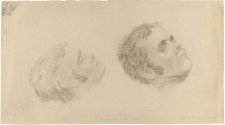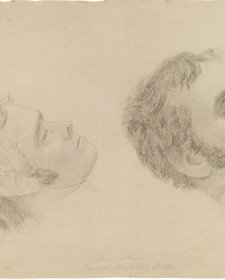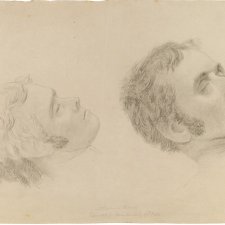Thomas Bock, artist, printmaker and photographer, is believed to have been born at Sutton Coldfield, near Birmingham, in 1790. He completed an apprenticeship as an engraver with Thomas Brandard in Birmingham and in 1814 established his own business there, advertising himself as an ‘Engraver and Miniature Painter’. In April 1823, Bock and a woman named Mary Day Underhill appeared at the Warwickshire Assizes charged with ‘administering concoctions of certain herbs to Ann Yates, with the intent to cause a miscarriage.’ Both were found guilty and sentenced to transportation for fourteen years. At the time of his conviction, Bock was thirty-two, married and father to five children. Bock arrived in Hobart aboard the Asia in January 1824. His convict record stated he had ‘served an apprenticeship to the Engraving Business’ and described him as ‘well connected and very orderly.’ The colonial authorities found immediate use for Bock, some of his earliest Tasmanian works being bank notes engraved for the Bank of Van Diemen’s Land and a drawing of executed cannibal, Alexander Pearce, made in July 1824 at the request of the Colonial Surgeon. Bock worked as a printmaker during the 1820s, engraving stationery along with illustrations for publications such as the Hobart Town Almanack while also producing portraits. He received a conditional pardon in 1832 and free pardon a year later, thereafter establishing a highly successful practice as Hobart’s most sought-after portrait artist. Bock was particularly known for his portrait drawings utilising watercolour, pencil, chalk and pastel (or ‘French crayon’), but his practice was diverse, incorporating printmaking and oil painting as well as photography. On his death in Hobart in March 1855 he was described as ‘an artist of a very high order’ whose works ‘adorned the homes of a number of our old colonists and citizens.’
Portraits
Jessie Robertson c. 1849
Thomas Bock Thomas Bock age 59
Jessie Whyte c. 1840
Thomas Bock Thomas Bock age 50



Fine and dandy
Whether the result of misadventure or misdemeanour, many accomplished artists were transported to Australia where they ultimately left a positive mark on the history of art in this country.



Public hanging
As a convict Thomas Bock was required to sketch executed murders for science; as a free man, fashionable society portraits.



Elegance in exile
Portrait drawings from colonial Australia
Elegance in exile is an exhibition surveying the work of Richard Read senior, Thomas Bock, Thomas Griffiths Wainewright and Charles Rodius: four artists who, though exiled to Australia as convicts, created many of the most significant and elegant portraits of the colonial period.




